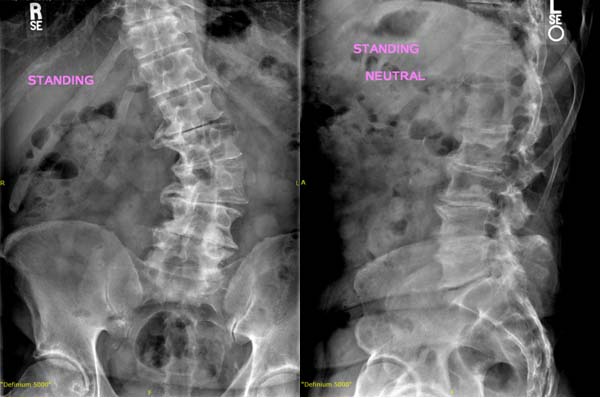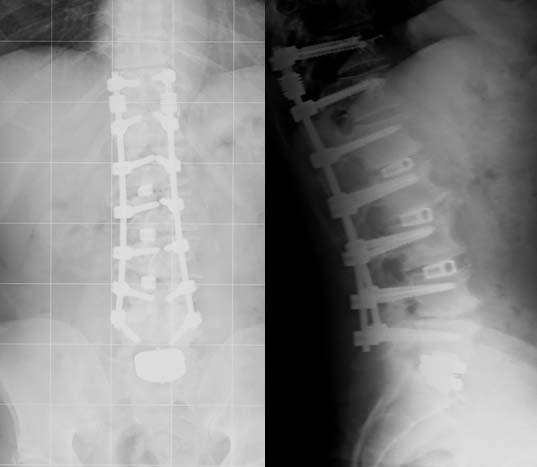360 Motion Preservation - California
January 2015
I am an American man who, over many years, suffered increasing debilitating back pain. Initially I was diagnosed with severe scoliosis that a US-based physician thought likely inoperable. As the years progressed my back continued to degenerate even with a stop-gap surgical intervention. In time it became clear that scoliosis was not my only problem. Several of my discs, from the base of my spine upwards, were deteriorating, while my spine, twisting at its base like a corkscrew, was shifting forward and sideways from the center of my body. All of this contributed to the worsening of my scoliosis. My profession required me to regularly divide my time between the US and Europe, but air and car travel were increasingly difficult due to my back issues.
Preop X-rays below:
I spent many years consulting prominent neurosurgeons in the U.S. as well as Italy before turning to Dr. Bertagnoli in Germany. Everyone but Dr. Bertagnoli proposed basically the same surgical procedure—full spinal fusion—with the same expected outcome—a significant loss of fluidity and mobility in my spine. If I had been decades older I might have settled for this sub-optimal solution, but as a physically active middle-aged man who worked 60-70 hours a week, a spine “frozen” for many decades of life was not an acceptable medical option.
Dr. Bertagnoli and his remarkable team offered me the solution I had hoped for–correct my degenerating spine while maintaining my mobility. Our initial communications, over the course of about two years, were by phone and email. We soon agreed that due to the complexity of my medical condition, it was imperative Dr. Bertagnoli see me in Bogen, Germany to do a personal evaluation, take up-to-date scans, and discuss his solution to my medical problems. We spent several hours discussing his assessment of my condition. Dr. Bertagnoli’s solution was dynamic stabilization of the spine using the pedicle screws US surgeons also use to support spinal fusions. These pedicle screws (or the dynamic stabilization procedure) have been refined over nearly two decades of successful spinal surgery. We also discussed his pre- and post-op plans and my hoped-for outcomes.
Before committing to Dr. Bertagnoli, I revisited two of the US neurosurgeons I had previously consulted. Both said the same thing. They had flown to Germany to observe Dr. Bertagnoli perform surgeries due to Dr. Bertagnoli’s research presentations in the U.S. and his published papers. Both see him as the best spinal surgeon in the world, one whom they themselves would use. This opinion was reiterated many times during my post-op stay in Germany and Italy, where I consulted local insurance firms and surgeons.
As we had agreed Dr. Bertagnoli performed two operations on me: the first, 10+ hours in length, approached my spine from the back; the second, about 6+ hours, approached my spine from the front of my body. These operations, only 7 days apart, had me walking within the first 24 hours. I knew after my first surgery that I had made the correct decision in choosing Dr. Bertagnoli.
It’s been five months since my surgeries. I spent 10 days post-op in the hospital in Bogen, followed by 10 days of additional recovery at a hotel in Straubing, Germany where Dr. Bertagnoli’s patients regularly recuperate. My room, outfitted with a personal espresso maker and a surgical bed, was a wonderful place to convalesce. Dr. Bertagnoli’s team of doctors and nurses regularly checked on every aspect of my after-care and he and I spoke frequently before he cleared me to leave Europe and return home.
Today my back has significantly better movement than before my surgery, my spine is in perfect balance and centrally positioned. I am standing upright, and my pain has almost completely disappeared.
Paul Ferrari
